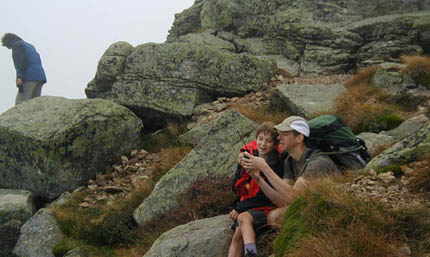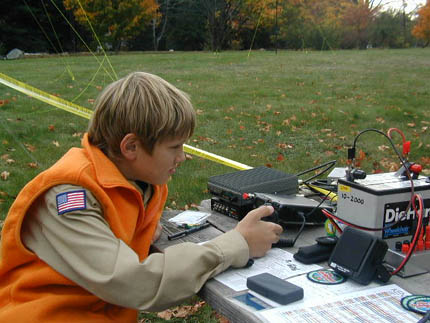
Welcome to the QTH of John Newell, KB1FPM
This page is a brief introduction to one of the things I enjoy doing. When I was in sixth grade (quite a few years ago now), I got a couple of ARRL books on passing the Novice exam and a key and oscillator. I never did get over learning the Morse Code. I did, however, become a teenage boy, and back in the early- to mid-1970s there were plenty of things to keep me busy. Cars, for example -- like my 1967 Camaro, which I sold when I graduated from college. The follies of youth...!
Skip forward quite a few years. I have two boys, and one of them became interested in amateur radio. One of the great things about having kids is that you get to have a second childhood, but make it look respectable! When the boys get a little older, I'll have to 'fess up, I guess -- but until then...
We got our Technician tickets (licenses, to non-hams) at the end of summer, 2000. No Morse Code test -- phew! Spurred on by things like the international scouting Jamboree On The Air, I took the written part of the General Class examination that fall, and thought I'd pass the Morse Code test shortly thereafter. Well, life is unpredictable, and Morse Code was still a challenge thirty years later. But I am stubborn, if nothing else, and I finally felt I was ready to pass the Morse Code element of the General Class requirements. I took the test and passed (phew again!). Later that year, I passed the Extra Class examination. More recently, my younger son has gotten his Technician license. The younger boy is much less shy than his older brother. Here's a picture of him and me doing a little 2 meter mountaintopping from Mount Lafayette in the New Hampshire White Mountains (dang, it's hard to read those little LCD panels with bifocals in the fog!). From that height, we could speak easily to stations well up the Maine coast using 5 watts and the factory rubber duck antenna.

The picture below is his older brother operating an in-the-field JOTA station several years ago. You can see the yellow nylon guy lines supporting a 10 meter center pole and two 20 foot end poles that were part of an 88 foot inverted Vee antenna that we ran (along with a Saint Louis Vertical with a W6MMA coil).

So, what's in the shack? As of May 2003, the shack looks like this:
|
What's all this stuff sitting in? A recycled computer hutch! Hey, I'm cheap, right? Main station power is an Alinco CM-330MV, 30+ watts. My sample is quiet on all frequencies. Additional power supplies include a 25w switcher and a 15w linear. Power distribution is through a West Mountain Radio Rig Runner -- possibly the best improvement I ever made to the station, dollar for dollar. Emergency station power is provided by a bank of four batteries (SLA and AGM) of various sizes and types that are kept on chargers full time. They are stored on the bottom shelf of the hutch with their chargers. A separate generator hookup is available to provide 3.5kW of AC power. |
You can probably pick out the pieces; the details are below.
|
The main HF radio in the station is a Kenwood TS-570S(G) with the 1.8kHz SSB optional filter installed. This radio is very easy to use and performs wonderfully on the air. I use it with a Kenwood MC-60 desk mic, an RCA accessory speaker, and a pair of Radio Shack headphones. |
| I recently replaced an LDG AT-11MP autotuner (150 watts) and an Ameritron ATR-15 (legal limit) tuner with an LDG AT-1000 autotuner to tune the 135' wire doublet that is my only current HF antenna. It tunes all bands quickly, and it is slightly quieter than my chainsaw while tuning. (!) This is a recent addition, but so far I'm very pleased with it, and really enjoy not having to tune manually when using the amplifier. |
|
|
For those times when band conditions are poor, which seems to be more often as the current solar cycle declines, the TS-570 is hooked up to an Ameritron AL-811H amplifier, which is good for 800 watts peak power. It is a snug fit in the hutch, so I added a 4" ~100cfm fan to draw air out through a hole in the side of the hutch on the left side of the amp to keep it running cooler. |
To help with tuning and to monitor transmitted power, I run an LDG DWM-4 digital wattmeter in line with the FT-817. I have the sensors for HF-2KW, HF-150W, HF- QRP and VHF. It's too bad this excellent and versatile little meter has been discontinued. If you look in the picture above, you'll also see a Kenwood SW-2100 200w/2kw SWR/wattmeter on top of the Kenwood TM-255A. This is currently used inline with a 1.5kw dummy load to assist with tuning the amp. |
|
|
The main VHF radio is a Kenwood TM-255A, a 40 watt, all-mode radio that performs superbly. It is hooked up to a Diamond X-50NA antenna mounted almost 45 feet up -- it gets very good coverage. I use this with a second RCA accessory speaker for clearer audio. I'm thinking of getting a 100 watt or greater amp for emergency use. |
The rig shown at the top of the stack on the right hand side above is a Yaesu FT-817. This radio covers 160 meters to 6 meters plus various other bands, including 2 meters, 70 centimeters, and FM broadcast. This is a five watt radio, but you'd be amazed what five watts will do with a decent antenna. One of the things I like about the FT-817 is that with the right equipment I can get reasonably high power output set up as a fixed station, but I can also yank the radio itself out of the setup, pack some batteries, a wire antenna and a small tuner like the Emtech ZM-2 and go. |
|
|
The FT-817 is hooked up to the 135 foot dipole through a Z-11 tuner from LDG Electronics, visible in the stack under the FT-817. Although it's advertised as a 30 watt tuner, LDG advises that this rating is for a 100% duty cycle -- as in, "I fell asleep on the key." |
| Five watts may be fine when the solar cycle is working our way, but for added dependability in fixed use, I am using a Tokyo Hy-Power HL-50B linear amplifier, also visible under the FT-817. This gives me up to 50 watts out, with appropriate spectral purity. Unfortunately, like the HT-750, this is not directly available in the U.S. |
|
|
Also in the stack under the FT-817 is a Kantronics KPC 3+ 1200 2baud packet modem used for packet communications. |
| What's in the vehicle, a 2000 Jeep Cherokee? A Kenwood TM-G707A. I like the detachable head and the large, seven-character alpha/numeric display. |
|
|
For handheld use, we have a few Kenwood TH-G71A handheld transceivers and recently got an Icom IC-T90A daylight-to-DC HT. We also have a Tokyo Hy-Power HT-750 that looks like a large HT but transmits and receives on 6, 15 and 40 meters in CW, LSB and USB. This unique radio is a real power miser, which makes it very suitable for combining with our backpacking interests. Combined with a lightweight wire antenna and a small tuner, or with its own telescoping antenna and tuned coils, it is a very capable performer. Unfortunately, it is at least temporarily out of production. |
| We also have a couple of AN-PRC/77 transceivers. These are the sibling of the AN/PRC-25, and differ mostly being entirely solid-state, while the PRC-25 had a tube in the final section. These are low-power, short-range VHF squad radios. They are also nearly legendary, many having been brought back into service during the 1991 Persian Gulf war -- not bad for radios that were introduced during the Vietnam war. They're heavy -- a PRC-77 mounted on an ALICE pack with a spare antenna or two, a spare battery and handset weighs more than 30 pounds. If you are interested in a little reading on these remarkable radios, you might enjoy this article written by Dennis Starks. |
|
|
The Z-11 is a great tuner and would be suitable for QRP use, of course, but it weighs twice as much as my little Emtech ZM-2. That makes the ZM-2 the preferred choice for portable, low power operation (under 15 watts). Mine is now in a slightly different case. I modified an LMB CR-532 case by shortening one half so that the other half makes "ears" that stick up to protect the connectors and knobs so we don't have another unfortunate accident like the one that damaged the first case... |
Last update 6/21/03